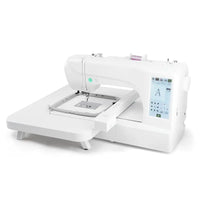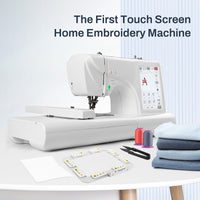Table of Contents
Getting Started: Understanding Your Brother CS6000i
Yemi begins with orientation. She points out each essential control—spool pin, tension dial, start/stop and reverse buttons, needle position, and speed slider—all designed for intuitive learning.


and

highlight how accessible everything is from the front panel, while the stitch chart

showcases the machine’s variety of built-in stitches. It’s a quick tour that boosts confidence before any thread is loaded.
The feed dogs and quick-set bobbin system

are standout features for smooth fabric movement. As a parallel, embroidery users often treasure reliability in their machines too, such as those with magnetic embroidery hoops for brother.
Mastering the Threads: Bobbin Winding and Machine Threading
Before you stitch, prepare your machine’s dual-thread system. Connect the power securely

to light up the digital screen, then start winding the bobbin. Hands guide the thread through the bobbin hole

; the motor quickly winds it evenly

. Insert the bobbin into its quick-set case

, ensuring the thread turns anticlockwise.
A recurring theme in viewer comments was thread tension. Thread bunching underneath often means re-checking both upper and lower threading paths. The tutorial shows how guiding the upper thread smoothly and catching the bobbin loop with the needle

eliminates that issue. Beginners comparing setups might note that precision in threading matters on all machines—from basic models to advanced options like brother embroidery machine.
Stitch Selection and Fabric Preparation
With threads ready and the machine humming, Yemi explains stitch selection using the LCD display
. Each digit corresponds to a number on the stitch chart; for basic straight seams, choose 01, adjusting length as needed. Beginners can experiment with decorative stitches later—something also familiar to those who venture into more advanced models featuring brother sewing and embroidery machine.
Before sewing, prep the fabric. Identify right and wrong sides, mark them with chalk, and pin with right sides facing
. Smooth preparation ensures clean seams.
Basic Sewing Techniques: Seams and Hems
Now the fun part: sewing your first straight seam! Place pinned fabric beneath the presser foot, lower it, and use the foot pedal to start. After a few stitches, hit the reverse button for a short backstitch. You’ll see it in action

. At the end, backstitch again, lift the foot, and clip threads easily with the built-in cutter

.
Many viewers asked how backstitching interacts with the pedal; Yemi clarified—you can keep the pedal pressed while holding the reverse button for smoother control.
When you’re ready, experiment with speed using the slider

. Beginners should aim for slow to medium; this builds muscle memory and control. Controlling speed is a foundational skill, whether for simple projects or future upgrades like a brother pr1055x multi-needle unit.
Next up: hems! With a double fold and a steady line, Yemi demonstrates creating a neat edge

. Always begin and end with a backstitch unless the seam is circular. Her relaxed teaching makes hems feel doable—no need to fear crooked lines.
> From the comments: Some users noticed their fabric wouldn’t feed. Ensure the feed-dog switch is engaged under the plate—once toggled, fabric movement resumes.
Proper sewing technique builds good habits for precision work, echoing the discipline also respected among embroidery users of brother embroidery hoops.
Correcting Mistakes: Your Best Friend, the Seam Ripper
Nobody gets a perfect seam every time. That’s why Yemi closes with the seam ripper—held like a pen, blade facing down

. Slide it under stitches and gently slice. The tiny red ball protects fabric from snags. Sharpen occasionally with an iron sponge and keep several on hand.
Removing stitches neatly isn’t failure—it’s skill. Even experienced sewists rely on this trusty tool daily.
Next Steps on Your Sewing Journey
By the end of Yemi’s tutorial, viewers feel empowered. Comments overflow with gratitude from first-time users who unboxed their Brother CS6000i after years of hesitation. Some even repaired clothes the same day!
Keep practicing short seams, adjusting tension, and experimenting with stitch types. Once you’re comfortable, you can explore creative accessories—from quilting attachments to specialty embroidery frames such as magnetic hoop for brother options—and truly personalize your maker corner.
> Sidebar Idea: Clean dust from the bobbin area regularly; oiling isn’t needed on this model.
Whether your goal is crafting garments, cushions, or future embroidery projects needing magnetic embroidery hoops, the foundation is the same—steady hands, correct setup, and patience.
Stay encouraged: every expert once threaded a bobbin for the first time.



